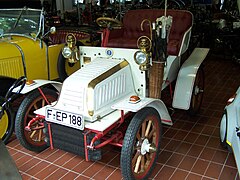This article needs additional citations for verification. (October 2009) |
Theodor Bergmann | |
|---|---|
| Born | Theodor Bergmann May 21, 1850 Sailauf, Germany |
| Died | March 23, 1931 (aged 80) Gaggenau, Germany |
| Occupation | industrialist |





Theodor Bergmann (May 21, 1850 in Sailauf – March 23, 1931 in Gaggenau)[1] was a German businessman and industrialist best remembered for the various revolutionary firearms his companies released. Like many entrepreneurs of the era, his activities centered on bicycles, and the nascent automobile. Armament was not Bergmann's primary focus, but the one he was most attracted to, which was the reason most of his pistols were manufactured under license once they were created. He is famous for creating automatic pistols, and their ammunition.
He managed Eisenwerke Gaggenau and sold his automobile activity to Carl Benz in 1910.
A new Bergmann model pistol was patented every year:
- Bergmann 1893
- Bergmann 1894
- Bergmann 1895
- Bergmann 1896
- Bergmann 1897 a.k.a. Bergmann Pieper
- Bergmann 1898
- Bergmann 1899
- Bergmann 1901 a.k.a. Bergmann Simplex
- Bergmann Mars
- Bergmann 1905
- Bergmann 1908 a.k.a. Bergmann–Bayard 1908
- Bergmann 1910 a.k.a. Bergmann–Bayard 1910
- Bergmann 1910/21 a.k.a. Bergmann–Bayard 1910/21
Bergmann designed the Bergmann MG15 nA Gun a LMG using a locking system he patented in 1901. It was used until World War II as the MG 15 machine gun
In 1915, the German Rifle Testing Commission at Spandau decided to develop a new weapon for trench warfare. The original intention had been to modify existing semi-automatic pistols, specifically the Luger and C96 Mauser. However, the mechanisms of these pistols were not suited to the stresses of full automatic fire, let alone the dirt and debris of the typical battlefield. In addition these light weight weapons were difficult to control in full automatic fire. Based upon this, the Commission determined that a completely new kind of weapon was needed.
Hugo Schmeisser, working for the Bergmann Waffenfabrik, was part of a team that designed a new type of weapon to fulfill the requirements, which was designated the MP18 or Maschinenpistole 18/I.
Theodor Bergmann's company still exists today as a plastics manufacturer.
- ^ Erich Keyser; Heinz Stoob, Deutsches Städtebuch, Handbuch städtischer Geschichte, Stuttgart, Kohlhammer Verlag, 1939. (page 239) OCLC 7303597